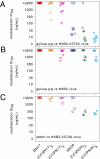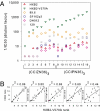Vaccination with peptide mimetics of the gp41 prehairpin fusion intermediate yields neutralizing antisera against HIV-1 isolates
- PMID: 20483992
- PMCID: PMC2890830
- DOI: 10.1073/pnas.1004261107
Vaccination with peptide mimetics of the gp41 prehairpin fusion intermediate yields neutralizing antisera against HIV-1 isolates
Abstract
Eliciting a broadly neutralizing polyclonal antibody response against HIV-1 remains a major challenge. One approach to vaccine development is prevention of HIV-1 entry into cells by blocking the fusion of viral and cell membranes. More specifically, our goal is to elicit neutralizing antibodies that target a transient viral entry intermediate (the prehairpin intermediate) formed by the HIV-1 gp41 protein. Because this intermediate is transient, a stable mimetic is required to elicit an immune response. Previously, a series of engineered peptides was used to select a mAb (denoted D5) that binds to the surface of the gp41 prehairpin intermediate, as demonstrated by x-ray crystallographic studies. D5 inhibits the replication of HIV-1 clinical isolates, providing proof-of-principle for this vaccine approach. Here, we describe a series of peptide mimetics of the gp41 prehairpin intermediate designed to permit a systematic analysis of the immune response generated in animals. To improve the chances of detecting weak neutralizing polyclonal responses, two strategies were employed in the initial screening: use of a neutralization-hypersensitive virus and concentration of the IgG fraction from immunized animal sera. This allowed incremental improvements through iterative cycles of design, which led to vaccine candidates capable of generating a polyclonal antibody response, detectable in unfractionated sera, that neutralize tier 1 HIV-1 and simian HIV primary isolates in vitro. Our findings serve as a starting point for the design of more potent immunogens to elicit a broadly neutralizing response against the gp41 prehairpin intermediate.
Conflict of interest statement
Conflict of interest statement: P.S.K. is an officer of Merck & Co., Inc. and holds stock and stock options in the company.
Figures




Similar articles
-
A fusion intermediate gp41 immunogen elicits neutralizing antibodies to HIV-1.J Biol Chem. 2014 Oct 24;289(43):29912-26. doi: 10.1074/jbc.M114.569566. Epub 2014 Aug 26. J Biol Chem. 2014. PMID: 25160627 Free PMC article.
-
A Derivative of the D5 Monoclonal Antibody That Targets the gp41 N-Heptad Repeat of HIV-1 with Broad Tier-2-Neutralizing Activity.J Virol. 2021 Jul 12;95(15):e0235020. doi: 10.1128/JVI.02350-20. Epub 2021 Jul 12. J Virol. 2021. PMID: 33980592 Free PMC article.
-
The high-affinity immunoglobulin receptor FcγRI potentiates HIV-1 neutralization via antibodies against the gp41 N-heptad repeat.Proc Natl Acad Sci U S A. 2021 Jan 19;118(3):e2018027118. doi: 10.1073/pnas.2018027118. Proc Natl Acad Sci U S A. 2021. PMID: 33431684 Free PMC article.
-
Progress towards the development of a HIV-1 gp41-directed vaccine.Curr HIV Res. 2004 Apr;2(2):193-204. doi: 10.2174/1570162043484933. Curr HIV Res. 2004. PMID: 15078183 Review.
-
Antigp41 membrane proximal external region antibodies and the art of using the membrane for neutralization.Curr Opin HIV AIDS. 2017 May;12(3):250-256. doi: 10.1097/COH.0000000000000364. Curr Opin HIV AIDS. 2017. PMID: 28422789 Review.
Cited by
-
Bringing immunofocusing into focus.NPJ Vaccines. 2024 Jan 9;9(1):11. doi: 10.1038/s41541-023-00792-x. NPJ Vaccines. 2024. PMID: 38195562 Free PMC article. Review.
-
Chimeric Human Papillomavirus-16 Virus-like Particles Presenting P18I10 and T20 Peptides from HIV-1 Envelope Induce HPV16 and HIV-1-Specific Humoral and T Cell-Mediated Immunity in BALB/c Mice.Vaccines (Basel). 2022 Dec 21;11(1):15. doi: 10.3390/vaccines11010015. Vaccines (Basel). 2022. PMID: 36679860 Free PMC article.
-
Chemically modified peptides based on the membrane-proximal external region of the HIV-1 envelope induce high-titer, epitope-specific nonneutralizing antibodies in rabbits.Clin Vaccine Immunol. 2014 Aug;21(8):1086-93. doi: 10.1128/CVI.00320-14. Epub 2014 May 28. Clin Vaccine Immunol. 2014. PMID: 24872518 Free PMC article.
-
Immunization with HIV-1 envelope T20-encoding DNA vaccines elicits cross-clade neutralizing antibody responses.Hum Vaccin Immunother. 2017 Dec 2;13(12):2849-2858. doi: 10.1080/21645515.2017.1338546. Epub 2017 Jul 11. Hum Vaccin Immunother. 2017. PMID: 28696158 Free PMC article.
-
Recent advances on the use of structural biology for the design of novel envelope immunogens of HIV-1.Curr HIV Res. 2013 Sep;11(6):464-72. doi: 10.2174/1570162x113116660053. Curr HIV Res. 2013. PMID: 24033298 Free PMC article.
References
-
- Zwick MB, Burton DR. HIV-1 neutralization: Mechanisms and relevance to vaccine design. Curr HIV Res. 2007;5:608–624. - PubMed
-
- Karlsson Hedestam GB, et al. The challenges of eliciting neutralizing antibodies to HIV-1 and to influenza virus. Nat Rev Microbiol. 2008;6:143–155. - PubMed
-
- Rerks-Ngarm S, et al. MOPH-TAVEG Investigators Vaccination with ALVAC and AIDSVAX to prevent HIV-1 infection in Thailand. N Engl J Med. 2009;361:2209–2220. - PubMed
MeSH terms
Substances
LinkOut - more resources
Full Text Sources
Other Literature Sources
Medical
Molecular Biology Databases

